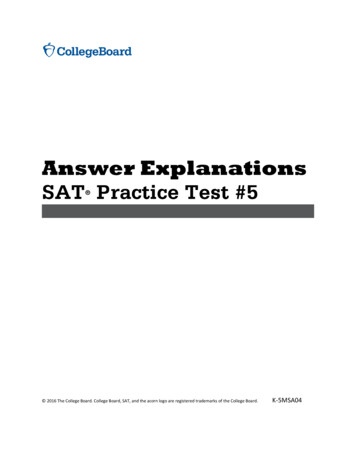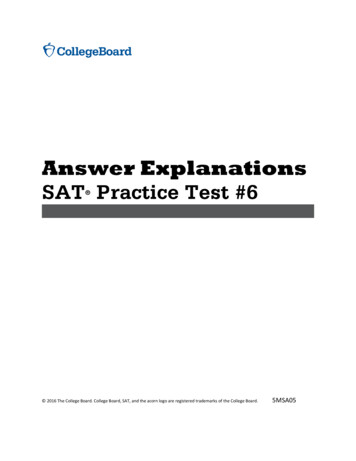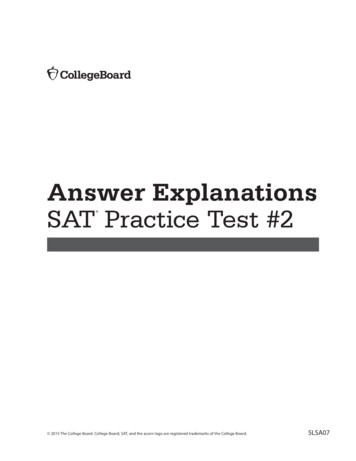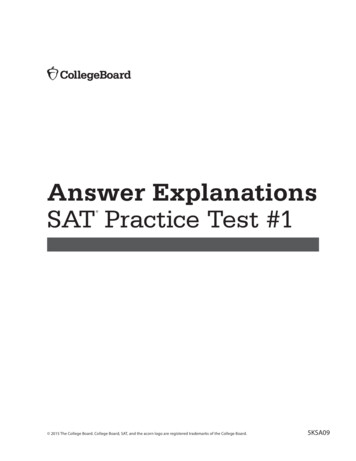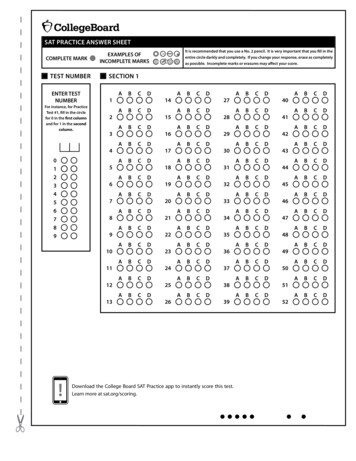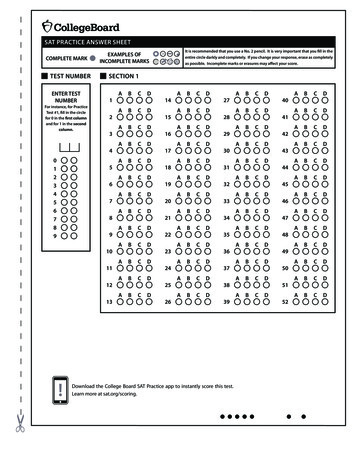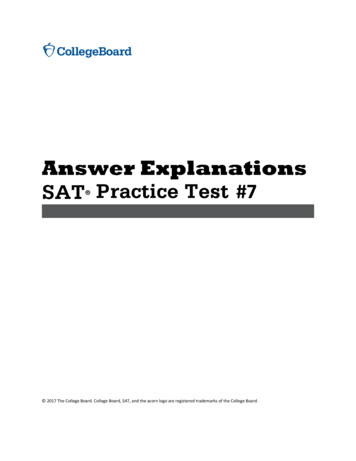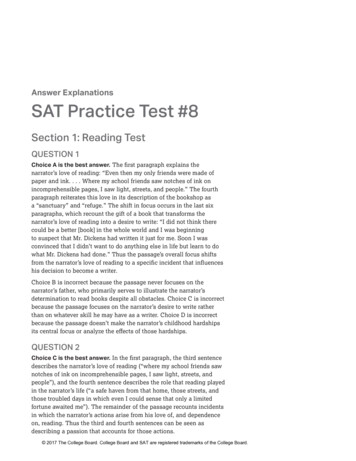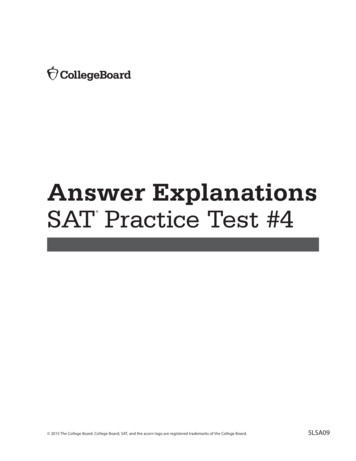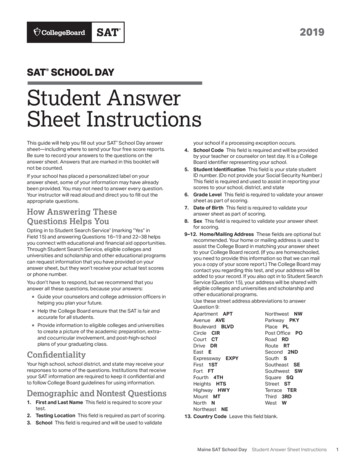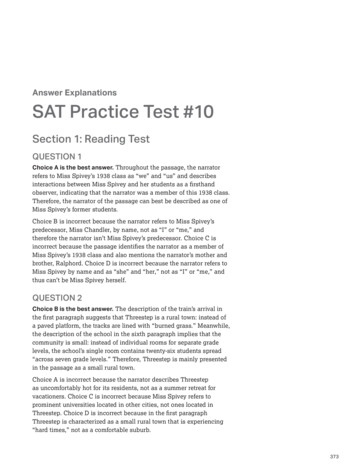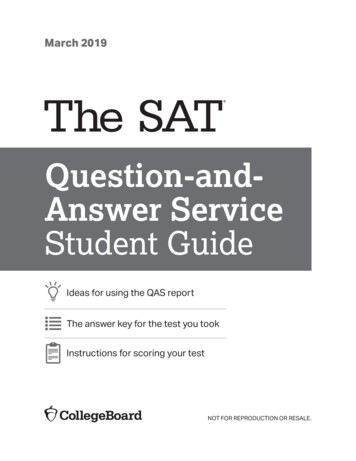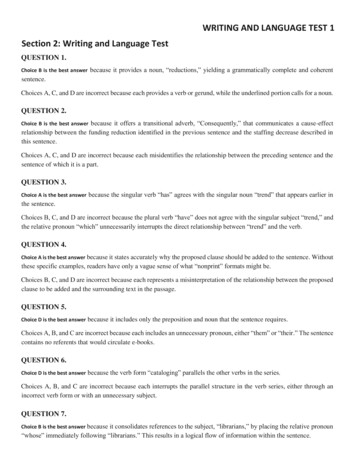
Transcription
WRITING AND LANGUAGE TEST 1Section 2: Writing and Language TestQUESTION 1.Choice B is the best answer because it provides a noun, “reductions,” yielding a grammatically complete and coherentsentence.Choices A, C, and D are incorrect because each provides a verb or gerund, while the underlined portion calls for a noun.QUESTION 2.Choice B is the best answer because it offers a transitional adverb, “Consequently,” that communicates a cause-effectrelationship between the funding reduction identified in the previous sentence and the staffing decrease described inthis sentence.Choices A, C, and D are incorrect because each misidentifies the relationship between the preceding sentence and thesentence of which it is a part.QUESTION 3.Choice A is the best answer because the singular verb “has” agrees with the singular noun “trend” that appears earlier inthe sentence.Choices B, C, and D are incorrect because the plural verb “have” does not agree with the singular subject “trend,” andthe relative pronoun “which” unnecessarily interrupts the direct relationship between “trend” and the verb.QUESTION 4.Choice A is the best answer because it states accurately why the proposed clause should be added to the sentence. Withoutthese specific examples, readers have only a vague sense of what “nonprint” formats might be.Choices B, C, and D are incorrect because each represents a misinterpretation of the relationship between the proposedclause to be added and the surrounding text in the passage.QUESTION 5.Choice D is the best answer because it includes only the preposition and noun that the sentence requires.Choices A, B, and C are incorrect because each includes an unnecessary pronoun, either “them” or “their.” The sentencecontains no referents that would circulate e-books.QUESTION 6.Choice D is the best answer because the verb form “cataloging” parallels the other verbs in the series.Choices A, B, and C are incorrect because each interrupts the parallel structure in the verb series, either through anincorrect verb form or with an unnecessary subject.QUESTION 7.Choice B is the best answer because it consolidates references to the subject, “librarians,” by placing the relative pronoun“whose” immediately following “librarians.” This results in a logical flow of information within the sentence.
Choices A, C, and D are incorrect because each fails to place “librarians” as the main subject of the sentence withoutredundancy, resulting in a convoluted sentence whose relevance to the preceding and subsequent sentences is unclear.QUESTION 8.Choice D is the best answer because no conjunction is necessary to communicate the relationship between the clauses inthe sentence. The conjunction “While” at the beginning of the sentence already creates a comparison.Choices A, B, and C are incorrect because each provides an unnecessary coordinating conjunction.QUESTION 9.Choice B is the best answer because it mentions time periods when the free services described later in the sentence areparticularly useful to library patrons.Choices A, C, and D are incorrect because each creates redundancy or awkwardness in the remainder of the sentence.QUESTION 10.Choice B is the best answer because it is concise; it is also consistent with the formal language in the rest of the sentenceand the passage overall.Choices A, C, and D are incorrect because each is either unnecessarily wordy or uses colloquial language that does notcorrespond with the tone of the passage.QUESTION 11.Choice C is the best answer because it restates the writer’s primary argument, which may be found at the end of the firstparagraph: “As public libraries adapt to rapid technological advances in information distribution, librarians’ roles areactually expanding.”Choices A, B, and D are incorrect because they do not paraphrase the writer’s primary claim.QUESTION 12.Choice B is the best answer because it clarifies that the sentence, which mentions a specific large-scale painting at the ArtInstitute of Chicago, is an example supporting the preceding claim about large-scale paintings.Choices A, C, and D are incorrect because they propose transitional words or phrases that do not accurately representthe relationship between the preceding sentence and the sentence containing the underlined portion.QUESTION 13.Choice D is the best answer because no punctuation is necessary in the underlined phrase.Choices A, B, and C are incorrect because each separates parts of the noun phrase “painter Georges Seurat’s 10-footwide A Sunday Afternoon on the Island of La Grande Jatte” from one another with one or more unnecessary commas.QUESTION 14.Choice C is the best answer because it provides the appropriate possessive form, “its,” and a colon to introduce theidentifying phrase that follows.
Choices A, B, and D are incorrect because none contains both the appropriate possessive form of “it” and thepunctuation that creates a grammatically standard sentence.QUESTION 15.Choice C is the best answer because an analysis of the consequences of King Louis XV’s reign is irrelevant to theparagraph.Choices A, B, and D are incorrect because each represents a misinterpretation of the relationship between the proposedsentence to be added and the main point of the paragraph.QUESTION 16.Choice C is the best answer because it provides a coordinating conjunction, “and,” to connect the two verb phrases “arecharacterized” and “are covered.”Choices A, B, and D are incorrect because each lacks the conjunction needed to connect the two verb phrases “arecharacterized” and “are covered.”QUESTION 17.Choice B is the best answer because it offers an example of an additional household item, a “tea cup,” with a specificmeasurement that is one-twelfth of its actual size.Choices A, C, D are incorrect because, compared to the example preceding the underlined portion, each is vague andfails to offer a specific measurement of an additional household item.QUESTION 18.Choice B is the best answer because it provides correct punctuation and the coordinating conjunction “but,” whichacknowledges the possible contrast between being “sparsely furnished” and displaying “just as true” period details.Choices A, C, and D are incorrect because each communicates an illogical relationship between the phrases that precedeand follow the underlined portion.QUESTION 19.Choice A is the best answer because it provides a clause that is the most similar to the two preceding clauses, which bothend with a reference to a specific wall.Choices B, C, and D are incorrect because each deviates from the stylistic pattern of the preceding two clauses.QUESTION 20.Choice D is the best answer because the article “a” requires the singular noun “visitor,” and the simple present verb“remark” is the appropriate verb tense in this context.Choices A, B, and C are incorrect because each contains either a noun or verb that does not fit the context.QUESTION 21.Choice D is the best answer because it identifies the drawers, rather than the visitor, as being “dotted with pin-sized knobs.”
Choices A, B, and C are incorrect because all three contain dangling modifiers that obscure the relationship betweenthe visitor, the drawers, and the pin-sized knobs.QUESTION 22.Choice B is the best answer because paragraph 3 offers an overview of the exhibit and so serves to introduce the specificaspects of particular miniature rooms described in paragraphs 2 and 4.Choices A, C, and D are incorrect because each proposes a placement of paragraph 2 that prevents the passage fromdeveloping in a logical sequence.QUESTION 23.Choice A is the best answer because it correctly completes the noun phrase that begins with “sea otters,” and directlyfollows the noun phrase with the verb “help.”Choices B, C, and D are incorrect because each separates the noun “otters” from the verb “help” in a way that resultsin a grammatically incomplete sentence.QUESTION 24.Choice B is the best answer because the data in the chart show lower sea urchin density in areas where sea otters have livedfor two years or less than in areas where no otters are present.Choices A, C, and D are incorrect because none accurately describes the data in the chart.QUESTION 25.Choice B is the best answer because the conjunctive adverb “however” accurately communicates the contrast between anenvironment shaped by the presence of sea otters, described in the preceding sentence, and an environment shaped bythe absence of sea otters, described in this sentence.Choices A, C, and D are incorrect because each presents a conjunctive adverb that does not accurately depict therelationship between the preceding sentence and the sentence with the underlined word.QUESTION 26.Choice A is the best answer because the additional information usefully connects the carbon dioxide levels mentioned inthis sentence with the global warming mentioned in the previous sentence.Choices B, C, and D are incorrect because each misinterprets the relationship between the proposed information andthe main points of the paragraph and the passage.QUESTION 27.Choice D is the best answer because it offers the verb “suggests” followed directly by its object, a that-clause, withoutinterruption.Choices A, B, and C are incorrect because each contains punctuation that unnecessarily separates the study from itsfindings—that is, separates the verb from its object.QUESTION 28.
Choice A is the best answer because it accurately reflects the fact that sea urchins “graze voraciously on kelp,” as stated inthe first paragraph, and it also maintains the tone of the passage.Choices B, C, and D are incorrect because each offers a term that does not accurately describe the behavior of sea otters.QUESTION 29.Choice C is the best answer because the possessive singular pronoun “its” corresponds with the referent “kelp,” whichappears later in the sentence, and with the possessive relationship between the pronoun and the “terrestrial plantcousins.”Choices A, B, and D are incorrect because none provides a pronoun that is both singular and possessive.QUESTION 30.Choice C is the best answer because it provides the noun “sea otters” to identify who or what “played a role.”Choices A, B, and D are incorrect because each provides a pronoun that makes no sense in the context of the paragraphand the passage, which is about the role sea otters play—not the role scientists play or the role kelp plays.QUESTION 31.Choice D is the best answer because sentence 5 indicates that sea otters’ importance in decreasing atmospheric carbondioxide was not known, and the sentence to be added indicates that a surprise will follow. Sentence 6 provides thatsurprise: sea otters have a large impact on the amount of carbon dioxide kelp can remove from the atmosphere.Choices A, B, and C are incorrect because each interrupts the logical flow of ideas in the paragraph.QUESTION 32.Choice B is the best answer because its clear wording and formal tone correspond with the passage’s established style.Choices A, C, and D are incorrect because each contains vague language that is inconsistent with the passage’s clearwording and formal tone.QUESTION 33.Choice D is the best answer because it provides punctuation that appropriately identifies “removed” as the definition of“sequestered.”Choices A, B, and C are incorrect because each contains punctuation that obscures the relationship between“sequestered,” “removed,” and the text that follows.QUESTION 34.Choice D is the best answer because it provides a conjunction that correctly identifies the relationship between “a practice”and the actions involved in the practice.Choices A, B, and C are incorrect because each contains a conjunction that miscommunicates the relationship betweenthe text that precedes and follows the underlined portion.QUESTION 35.
Choice A is the best answer because it provides a comma to close the appositive clause “a practice whereby products aredesigned to have a limited period of usefulness,” which also begins with a comma.Choices B, C, and D are incorrect because each provides closing punctuation inconsistent with the punctuation at thebeginning of the clause.QUESTION 36.Choice D is the best answer because it provides an adjective that accurately describes the clear “contrast” between products“designed to have a limited period of usefulness” and those “produced to be durable.”Choices A, B, and C are incorrect because none provides an adjective that appropriately modifies “contrast” in thecontext of the paragraph.QUESTION 37.Choice A is the best answer because by mentioning the “specialized” methods used in repair shops, it suggests thatrepairing goods is seen as a specialty rather than as a common activity. This connects logically with the “rare” repairshops introduced just before the underlined portion.Choices B, C, and D are incorrect because none provides information that supports the claim made in the sentence.QUESTION 38.Choice B is the best answer because it provides the correct spelling of the noun “fair,” meaning exhibition, and uses thecorrect word “than” to create the comparison between a “fair” and a “café.”Choices A, C, and D are incorrect because each contains a misspelling of either “fair” or “than.”QUESTION 39.Choice C is the best answer because it offers a relative pronoun that properly links the noun “Martine Postma” with theappropriate verb “wanted.” Choices A, B, and D are incorrect because none contains a pronoun that is appropriate forthe referent and placement of the clause.QUESTION 40.Choice D is the best answer because it provides the most concise phrasing and links the sentence appropriately to theprevious sentence.Choices A, B, and C are incorrect because each provides an unnecessary adverb that obscures the relationship betweenthis sentence and the previous one.QUESTION 41.Choice D is the best answer because the gerund “waiting” corresponds with the preposition “for” and the present tenseused in the rest of the sentence.Choices A, B, and C are incorrect because e
Choice A is the best answer because it accurately reflects the fact that sea urchins “graze voraciously on kelp,” as stated in the first paragraph, and it also maintains the tone of the passage. Choices B, C, and D are incorrect because each offers a term that does not accurately describe the behavior of sea otters. QUESTION 29. Choice C is the best answer because the possessive singular .File Size: 421KBPage Count: 27Explore furtherScoring Your SAT Practice Test #8www.powerscore.comQuiz & Worksheet - PSAT Writing & Language Test Passages .study.comAnswer Explanations #7 - The SAT Suite of Assessmentssat-edit.collegeboard.orgRecommended to you based on what's popular Feedback
